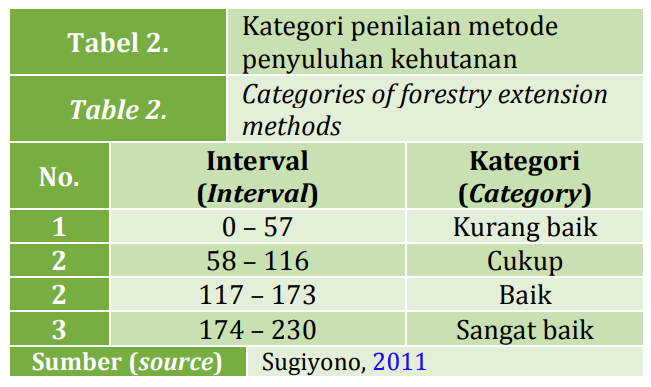Implementation of forest extension methods in improving the knowledge and skills of forest farmers in Maros District
Case study on forestry extension methods in Tompobulu District, Maros Regency

Downloads
The forestry extension method is a service system that helps the community, especially farmers and communities around the forest, in education, knowledge, implementation of techniques, and methods of utilizing and preserving forest resources. The study aimed to determine the forms of forestry extension methods in Tompobulu District and analyze the effect of forestry extension learning methods in increasing the knowledge and skills of forest farmers in Maros District. Data analysis was carried out to analyze forestry extension methods using qualitative descriptive analysis with a Likert scale. While the analysis used to analyze the forestry extension method in improving the knowledge and skills of forest farmers in Tompubulu District is quantitative analysis with t-test. The results of the study stated that the forestry extension methods implemented were 1) direct communication method, 2) method through teaching aids messages, 3) method based on individual approach, 4) method based on group approach, 5) participatory method, and 6) technology-based method, information, and communication (ICT). The effect of forestry extension methods that have a significant effect in increasing the knowledge and skills of forest farmers are direct communication methods, methods based on individual approaches, and participatory methods. At the same time, the methods that do not significantly affect the increase in knowledge and skills of forest farmers are the method through the message of teaching aids, the method based on the group approach, and the method based on technology, information, and communication (ICT)
Ban, A. W. van den, Hawkins, H. S., & Herdiasti, A. D. (1999). Penyuluhan Pertanian. Kanisius.
Fauzi, H. (2017). Pengetahuan Penyuluh Kehutanan Sebagai Pelaku Pemberdayaan Masyarakat dalam Pengelolaan Hutan. Jurnal Hutan Tropis, 5(1), 14–21.
Harinta, Y. W. (2011). Adopsi Inovasi Pertanian di Kalangan Petani di Kecamatan Gatak Kabupaten Sukoharjo. Agrin, 15(2), 164–174.
Kandzior, A., & Rivas, E. (2014). Application of a Participatory Approach to Forestry Extension Activities BT - Tropical Forestry Handbook (L. Pancel & M. Ko hl (Eds.); pp. 1–12). Springer Berlin Heidelberg.
Lawrence, A., Deu, P., Hujala, T., Nichiforel, L., Feliciano, D., Jodlowski, K., Lind, T., Marchal, D., Talkkari, A., Teder, M., Vilkriste, L., & Wilhelmsson, E. (2020). Extension , advice and knowledge systems for private forestry : Understanding diversity and change across Europe. Land Use Policy, 94(December 2019).
Mahbub, M. (2007). Penyuluhan Kehutanan Partisipatif. Jurnal Hutan dan Masyarakat, 2(3), 313-318.
Mardikanto, T. (2009). Sistem Penyuluhan Pertanian. Surakarta. Universitas Sebelah Maret Press.
Mujiburrahmad, M., Muljono, P., & Sadono, D. (2015). Kinerja Penyuluh Pertanian di Kabupaten Pidie Provinsi Aceh dalam Melaksanakan Tugas dan Fungsi. Jurnal Penyuluhan, 10(2), 141–150.
Sapar, Jahi, A., Asngari, P. S., Amiruddin, & Purnaba, I. G. P. (2012). Kinerja Penyuluh Pertanian dan Dampaknya pada Kompetensi Petani Kakao di Empat Wilayah Sulawesi Selatan. Jurnal Penyuluhan, 8(1), 54-57.
Sugiyono. (2011). Metode Penelitian Bisnis. CV. Alfabeta.
Suharsimi, A. (2010). Prosedur Penelitian Suatu Praktik. In Revisi VI. Rineka Cipta.
Sumardjo, & Mulyandari, R. S. H. (2011). Pengembangan sistem informasi berbasis teknologi Informasi untuk pemberdayaan petani sayuran. Prosiding Hasil-Hasil Penelitian IPB 2011, p472.
Suyadi, Sumardjo, Uchrowi, Z., & Tjitropranoto, P. (2019). Pengaruh Penyuluhan Kehutanan Terhadap Peran Kepemimpinan Informal di Lingkungan Taman Nasional Gunung Ciremai Provinsi Jawa Barat. Jurnal Penelitian Sosial dan Ekonomi Kehutanan. 16(1), 25–41.
Zega Hutan. (2020). Metode Penyuluhan Kehutanan Terbaru. Materi. https://www.zegahutan.com/2020/03/metode-penyuluhan-kehutanan-terbaru.html.




